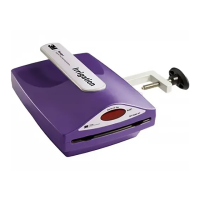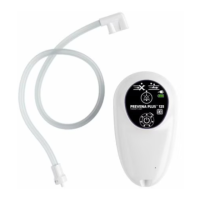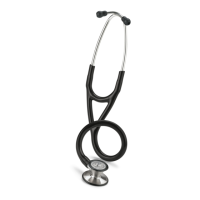12
<5% U
T
(>95% dip in U
T
) for 0,5 cycle
40% U
T
(60% dip in U
T
) for 5 cycles
70% U
T
(30% dip in U
T
) for 25 cycles
<5% U
T
(>95% dip in U
T
) for 5 sec
U
T
is the a.c. mains voltage prior to
application of the test level.
Mains power quality should be that of a typical commercial or hospital environment. If the user of
the model 675 requires continued operation during power mains interruptions, it is recommended
that the model 675 be powered from an uninterruptible power supply or a battery.
Power frequency (50/60 Hz) magnetic field, IEC 61000-4-8
30 A/m Power frequency magnetic fields should be at levels characteristic of a typical location in a typical
commercial or hospital environment.
IEC 60601
test level
Electromagnetic environment - guidance
Conducted RF, IEC 61000-4-6, and Radiated RF, IEC 61000-4-3
6 Vrms, 150 kHz to 80 MHz
10 V/m, 80 MHz to 2,5 GHz
Portable and mobile RF communications equipment should be used no closer to any part of the
model 675, including cables, than the recommended separation distance calculated from the
equation applicable to the frequency of the transmitter.
Recommended separation distance
d = 1.2
d = 1.2 80 MHz to 800 MHz
d = 2.3
800 MHz to 2,5 GHz
where P is the maximum output power rating of the transmitter in watts (W) according to the
transmitter manufacturer and d is the recommended separation distance in meters (m).
At 80 MHz and 800 MHz, the higher frequency range applies.
Field strengths from fixed RF transmitters, as determined by an electromagnetic site survey,
a
should be less than the compliance level in each frequency range.
b
Interference may occur in the vicinity of equipment marked with the following symbol:
Notes
a
Field strengths from fixed transmitters, such as base stations for radio (cellular/cordless) telephones and land mobile radios, amateur
radio, AM and FM radio broadcast and TV broadcast cannot be predicted theoretically with accuracy. To assess the electromagnetic
environment due to fixed RF transmitters, an electromagnetic site survey should be considered. If the measured field strength in the
location in which the model 675 is used exceeds the applicable RF compliance level above, the model 675 should be observed to verify
normal operation. If abnormal performance is observed, additional measures may be necessary, such as re-orienting or relocating the
model 675.
b
Over the frequency range 150 kHz to 80 MHz, field strengths should be less than 3 V/m.
Recommended separation distances between portable and mobile RF communications equipment and the model 675
The model 675 is intended for use in an electromagnetic environment in which radiated RF disturbances are controlled. The customer or
the user of the model 675 can help prevent electromagnetic interference by maintaining a minimum distance between portable and mobile
RF communications equipment (transmitters) and the model 675 as recommended below, according to the maximum output power of the
communications equipment.
Rated maximum output
power of transmitter
W
Separation distance according to frequency of transmitter (m)
150 kHz to 80 MHz
d = 1.2
80 MHz to
800MHz
d = 1.2
800 MHz to 2,5 GHz
d = 2.3
0,01 0.12 0.12 0.23
0,1 0.38 0.38 0.73
1 1.2 1.2 2.3
10 3.8 3.8 7.3
100 12 12 23
For transmitters rated at a maximum output power not listed above, the recommended separation distance d in meters (m) can be estimated
using the equation applicable to the frequency of the transmitter, where P is the maximum output power rating of the transmitter in watts
(W) according to the transmitter manufacturer.
Notes
At 80 MHz and 800 MHz, the separation distance for the higher frequency range applies.
These guidelines may not apply in all situations. Electromagnetic propagation is affected by absorption and reflection from structures,
objects and people.
13
Classifications
• Protection against electric shock: Class I Medical Electrical
Equipment with Type BF applied part.
• Protection against ingress of water: IPX1
• Mode of operation: Continuous operation.
Not suitable for use in the presence of flammable anesthetic mixtures
with air or with oxygen or nitrous oxide.
MEDICAL – GENERAL MEDICAL EQUIPMENT AS
TO ELECTRIC SHOCK, FIRE AND MECHANICAL
HAZARDS ONLY IN ACCORDANCE WITH ANSI/
AAMI ES 60601-1 (2005) + AMD (2012), CAN/
CSA-C22.2 No. 60601-1 (2008) + (2014), IEC
80601-2-35 (2009) + AMD (2016), IEC 60601-
1-6:2010 (Third Edition) + A1:2013, IEC 60601-1-
8:2008 (Second Edition) + A1:2012; Control No.
4HZ8

